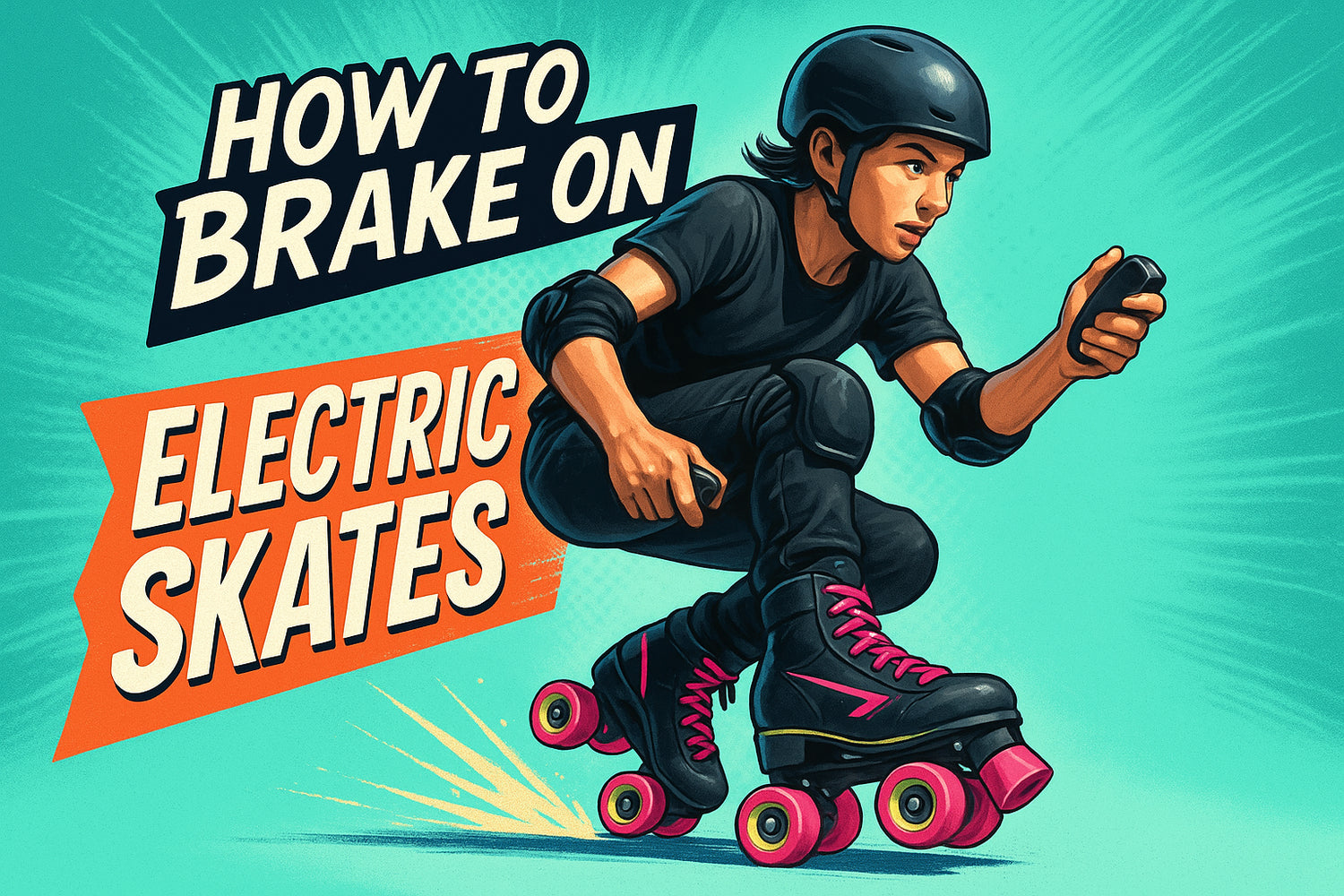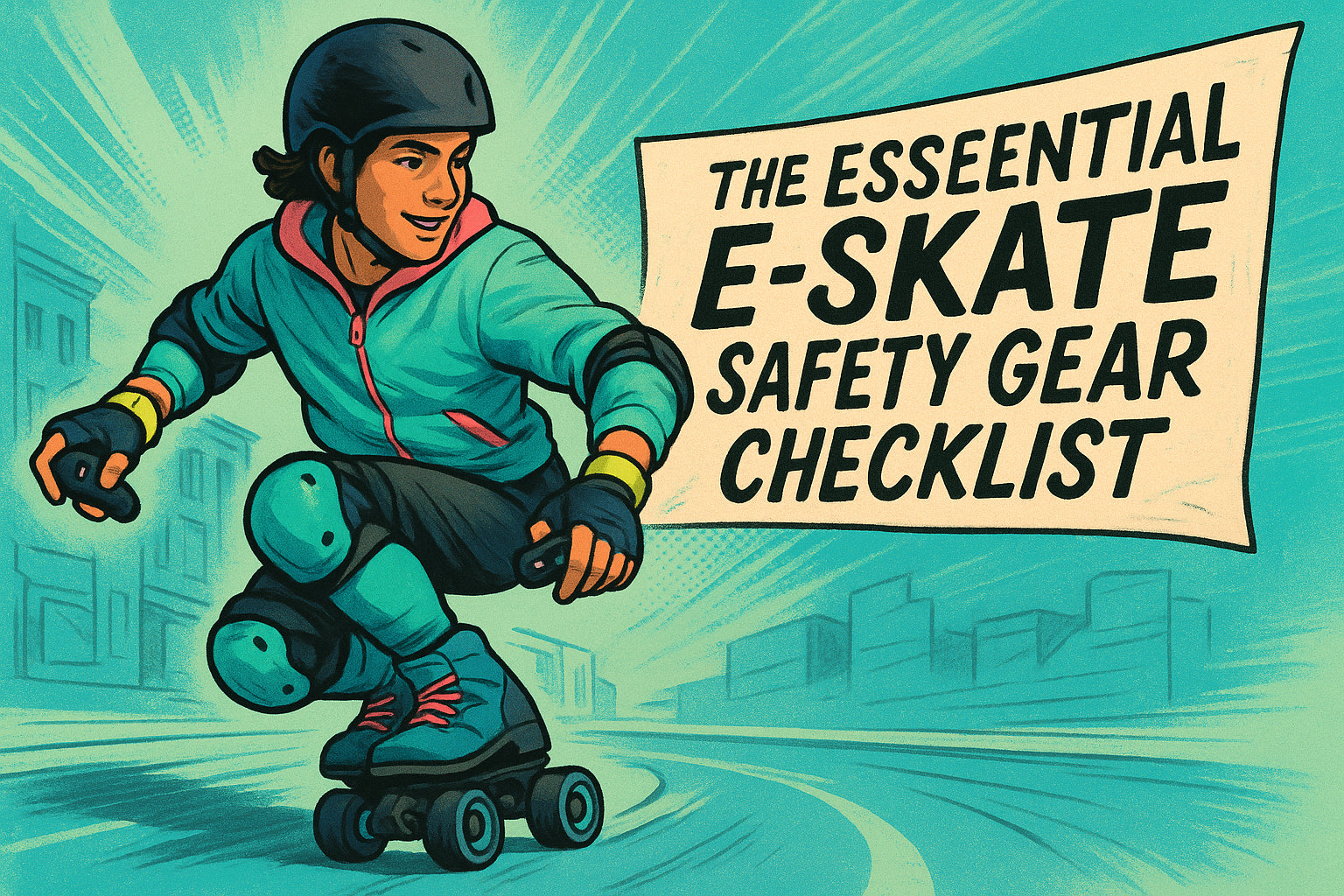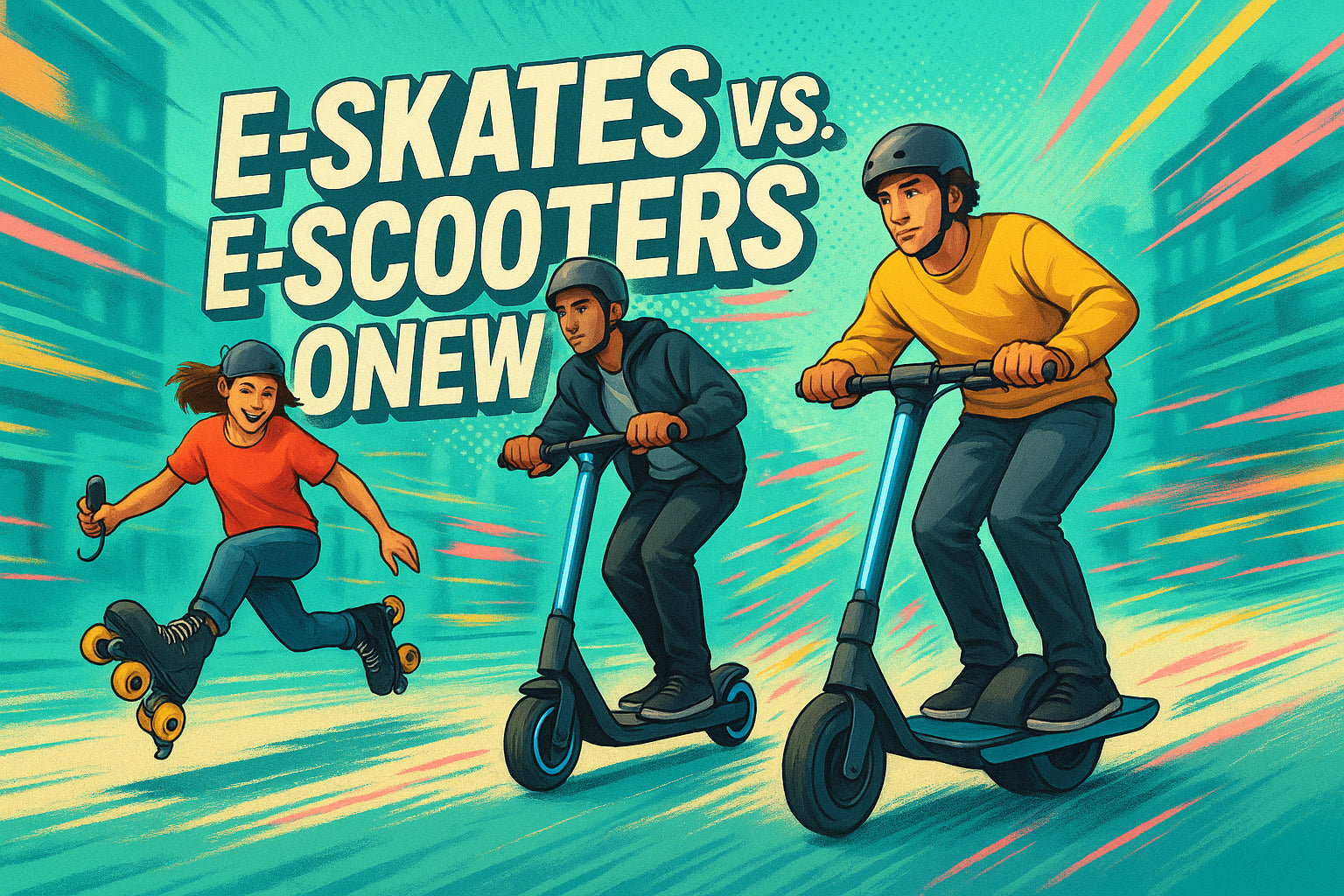Electric skates can reach high speeds, making proper braking essential for safety. Whether you're navigating busy streets or avoiding obstacles, knowing how to stop effectively can prevent accidents. Here’s a quick guide to the three key braking techniques:
- Electronic Braking: Use the wireless remote to control speed and stop smoothly. This method is ideal for beginners and works well at speeds up to 15 mph.
- T-Stop: A manual technique where you drag one skate behind the other to create friction. Great for intermediate riders and situations where electronic braking isn’t available.
- Plow Stop: Angle your skates into a "V" shape and apply outward pressure to slow down. This is beginner-friendly and works well on flat surfaces.
Each method has its strengths, so practice in safe areas to build confidence and control. Mastering these techniques ensures a safer ride, whether you're cruising through the park or tackling urban traffic.
LEARN HOW TO STOP ON INLINE SKATES! ✋ tutorial
Electronic Braking with the Wireless Remote Control
The wireless remote control is the key to braking on Wheelfeet skates, offering smooth and consistent stopping power. By turning the motors into generators during braking, the system ensures a controlled deceleration that feels more predictable than manual methods. Let’s dive into how to make the most of this feature for safe and effective stops.
How to Use the Remote for Controlled Braking
Before hitting the road, take time to understand the remote’s speed modes and function keys. This will help you fine-tune the braking intensity to suit your needs.
For a smooth stop, gently press the brake control on the remote. Consistency is crucial - apply steady pressure rather than sudden, sharp inputs. Gradual adjustments to the throttle will prevent abrupt halts and keep your ride smooth.
Your body posture plays a big role in braking effectively. Stay centered over your skates, keep your knees bent for stability, and extend your arms to maintain balance. When braking, lean back slightly to shift more weight onto the rear brakes, ensuring an even weight distribution.
It’s also helpful to practice varying your braking force based on your speed and the terrain, so you’re prepared for different riding conditions.
Safety Guidelines for Remote Control Use
The battery level directly impacts braking performance. A low charge can reduce responsiveness, making stops less reliable. Always check your battery before heading out and avoid running it completely down.
Before riding in busy areas, test your brakes at low speeds in a safe environment. This ensures everything is functioning properly. When navigating downhill or through traffic, keep your fingers on the brake control and maintain a safe distance from others - whether they’re riders, vehicles, or pedestrians.
To avoid sudden stops, release the throttle gradually and adjust the pressure as needed to match the conditions around you.
How Regenerative Braking Works
Wheelfeet skates feature regenerative braking, a system that recovers energy during stops and sends it back to the battery. When you apply the brakes, the motors shift from driving the wheels to generating electricity, converting the deceleration into stored energy. This recovered energy is then stored in the battery for later use.
Regenerative braking doesn’t just improve efficiency - it helps extend the battery’s lifespan by reducing strain on the initial charge. While it can’t fully recharge the battery during braking, it does increase your overall riding range.
This system works best at moderate to high speeds, where it can recover more energy. At very low speeds, energy recovery is minimal, but the electronic braking still provides reliable, smooth stops. By understanding these dynamics, you can plan your braking strategy more effectively. Use electronic braking for most situations and save manual techniques for emergencies or when the battery is running low.
Manual Braking Methods for Electric Skates
When electronic braking isn't an option or when you need extra control, manual braking techniques step in. These classic methods operate independently of technology, giving you a reliable way to slow down. Knowing how to perform both the T-Stop and Plow Stop can prepare you for all kinds of riding conditions.
T-Stop Method: How It Works
The T-Stop is a go-to technique for intermediate skaters. It's a reliable way to stop on flat surfaces and control your speed on slopes, making it a versatile skill to have.
Here’s how to do it: Shift your weight onto your front skate - this serves as your anchor. Then, position your trailing skate perpendicular to the front one, creating a "T" shape when viewed from above. Gently drag the back skate along the ground to create friction, gradually increasing the pressure to slow down without losing balance.
Keep your core tight, knees slightly bent, and arms extended for stability. Your front leg should absorb any sudden shifts in momentum, so stay steady and controlled.
The T-Stop is particularly useful for skates without built-in brakes, offering a reliable manual option when electronic systems aren't available. Another effective method to have in your toolkit is the Plow Stop, which provides a different approach to slowing down.
Plow Stop Method: Steps and Uses
The Plow Stop, sometimes called the snowplow stop, is another manual braking technique. It’s a bit easier for beginners and works well for gradual deceleration.
Start by widening your stance to about shoulder-width apart. Slowly angle your toes inward while pushing your heels outward, forming an upside-down "V" shape. Keep both skates in contact with the ground and apply outward pressure through your legs. The friction created by the angled wheels will help you slow down.
To stay balanced, keep your weight evenly distributed, your knees bent, and your center of gravity low. This position provides stability and reduces the risk of falling.
The Plow Stop works best on flat, open surfaces where you have room to slow down gradually. It’s not ideal for sudden stops but is perfect for controlled deceleration.
Choosing the Right Technique
Deciding which method to use depends on your skill level, speed, and the space available. The T-Stop is more advanced and requires better balance and coordination, making it a good choice for tighter spaces or when you need to stop quickly. It also handles slight inclines well but demands more practice to perfect.
The Plow Stop, on the other hand, is beginner-friendly and works best at moderate speeds on flat terrain. It’s a forgiving technique that offers stability, making it ideal for situations where you can decelerate gradually.
To master these techniques, practice in safe environments and on different surfaces. Each type of terrain offers varying levels of friction, so understanding how these methods perform under different conditions is key to safe riding. Regular practice will also help you develop the muscle memory needed to execute these stops confidently when electronic brakes aren’t available.
sbb-itb-bf837b9
Braking During Mode Switching: Electric to Manual
Wheelfeet electric skates allow riders to switch between electronic and manual braking. This shift changes how you stop and demands a smooth transition to maintain control. It also highlights the importance of mastering the manual braking techniques discussed earlier.
How Dual-Mode Operation Affects Braking
In electric mode, you can rely on regenerative braking, controlled through a wireless remote. This system not only provides smooth deceleration but also recharges the battery during use. It’s highly effective for precise stops at speeds up to 15 mph (25 km/h).
Switching to manual mode, however, removes this electronic assistance. At this point, you must rely on manual braking methods like the T-Stop or Plow Stop. This shift can feel abrupt, especially at higher speeds, as the smooth deceleration of regenerative braking is no longer available. Instead, you’ll notice an immediate change in how the skates respond to your braking efforts.
One factor to consider is the sensitivity settings in electric mode. Higher sensitivity can make the transition to manual braking feel more abrupt. Adjusting these settings to a lower level can help create a gentler shift when switching modes.
Smooth Transition Techniques
To ensure safe and controlled mode switching, focus on preparation and technique:
- Anticipate the switch. Don’t wait until the last second to change modes, especially if you need to stop soon. Plan ahead and give yourself plenty of time and space to adjust.
- Reduce speed early. If you know a mode change is coming, start slowing down with the electronic brakes well in advance. This creates a buffer, making the transition to manual braking smoother and safer.
- Adjust your stance. Lower your center of gravity, bend your knees slightly, and engage your core. This balanced posture helps you absorb any sudden shifts in momentum during the transition.
- Apply gradual pressure. Whether moving from electronic to manual braking or vice versa, use steady, controlled pressure. Techniques like the T-Stop and Plow Stop are especially helpful here, as they promote stability and prevent accidents.
- Know your remote settings. Familiarize yourself with the remote control, particularly any ramping times that might delay braking responses. Adjust these settings for quicker reactions when switching modes.
The best way to master these transitions is through consistent practice in a safe environment. Find an open space to work on switching between modes while maintaining control. This repetition builds muscle memory and confidence, preparing you for real-world scenarios where quick transitions might be necessary.
Braking Methods Comparison Chart
Selecting the best braking technique depends on your experience level, the terrain, and the specific circumstances you're facing. Each method has its strengths, making it suitable for different scenarios. For detailed instructions on each technique, refer to the earlier sections.
Quick Reference: All Braking Techniques
| Braking Method | Ease of Use | Stopping Power | Best For |
|---|---|---|---|
| Electronic/Regenerative | Very Easy | High | Beginners |
| T-Stop | Moderate | Medium | Intermediate riders |
| Plow Stop | Moderate | High | Quad skaters and beginners |
Electronic braking is the most beginner-friendly choice. Using a wireless remote, it ensures smooth and controlled braking by engaging both wheels at once, minimizing the chances of wheel lock-ups or skidding. Research from Stopskate shows that electronic braking systems improve skating safety by 65% and achieve 53% faster stops compared to traditional mechanical brakes.
"Braking with EBS is very easy, comfortable and safe and you will learn it in a few minutes." – Stopskate s.r.o.
The T-Stop method is a reliable option for intermediate riders. While it requires practice, it provides solid stopping power for a variety of situations.
The Plow Stop technique demands good leg strength and balance. This method involves widening your stance and applying outward pressure with both skates, making it particularly useful for quad skaters and beginners looking to improve their control.
Each method has specific advantages depending on the situation. For example, in crowded areas, electronic braking offers the precision needed to handle unexpected obstacles while maintaining control. On steep hills, it's crucial to start braking early with steady, gentle pressure. For longer descents, intermittent "pulse braking" helps prevent overheating. In emergencies, shift your weight backward and apply approximately 70% braking force immediately. On wet surfaces, reduce braking force by about 30% and allow for a longer stopping distance.
To build confidence, begin with electronic braking and then gradually learn manual techniques for added versatility. Use this chart as a handy guide to choose the most effective method for your riding conditions.
Conclusion: Practice These Techniques for Safe Riding
Mastering the electronic braking, T-Stop, and Plow Stop methods is essential for ensuring a safer and more controlled ride. Each braking technique plays a unique role, and knowing when to use them can make all the difference in maintaining stability and control.
Start with electronic braking, which relies on your wireless remote control. This beginner-friendly method provides consistent and reliable stopping power, especially at speeds up to 15 mph. It’s a great way to build confidence before moving on to manual techniques. Once you’re comfortable, incorporate the T-Stop for situations that require manual control. Finally, use the Plow Stop when you need maximum stopping power or are transitioning between electric and manual braking modes.
Practice in safe, controlled environments to refine your skills. Begin at slower speeds, applying steady pressure to the brakes to avoid skidding. Maintain a balanced stance - keep your feet evenly spaced and your knees slightly bent to optimize stability. Gradually increase your speed as your confidence grows.
Expand your practice to include real-world scenarios. Work on braking techniques while going uphill or downhill to improve weight distribution. Practice quick braking while steering to prepare for sudden obstacles. And always wear proper safety gear during these sessions.
Before each ride, check your brakes and review your Wheelfeet controller settings. Many electric skates allow you to adjust braking sensitivity and modes, which can significantly impact how your brakes respond. Set personal goals to improve your reaction time or perfect smooth, gradual stops. These small steps will help you continuously refine your braking skills.
With regular practice and attention to these techniques, you’ll be ready for all kinds of riding situations, whether it’s navigating busy streets or cruising through a park. Prioritize safety and keep practicing to enjoy a confident and secure ride.
FAQs
What makes electronic braking on electric skates better than manual braking?
Electronic braking on electric skates brings some standout benefits compared to manual methods. For starters, it delivers quicker response times and ensures steady, reliable stopping power, which can significantly boost safety during rides. Unlike traditional brakes that depend on friction, electronic systems avoid this, cutting down on wear and tear and helping your skates last longer.
These advantages make electronic braking a more practical and efficient choice, offering riders improved control and peace of mind across different riding scenarios.
What is regenerative braking on electric skates, and how does it impact battery life?
Regenerative braking on electric skates uses the motor to transform your momentum into electrical energy, which gets stored back in the battery. This clever process not only ensures a smooth and controlled stop but also gives your battery a little extra juice as you ride.
By capturing energy that would otherwise go to waste, regenerative braking can slightly boost your battery life. This means longer rides and fewer charging breaks - an efficient feature that adds to both the performance and the eco-friendliness of your ride.
How do I safely switch between electronic and manual braking on electric skates?
To switch safely between electronic and manual braking on electric skates, start by practicing in a controlled setting. A flat, open space with smooth pavement is ideal. Take your time transitioning between braking modes to avoid sudden stops or losing control.
Get to know your skate's remote control and braking options thoroughly. Regular practice will not only make these transitions smoother but also boost your confidence in handling different riding conditions. And don’t forget - safety comes first. Always wear protective gear and stay alert to what’s happening around you.




Leave a comment
All comments are moderated before being published.
This site is protected by hCaptcha and the hCaptcha Privacy Policy and Terms of Service apply.